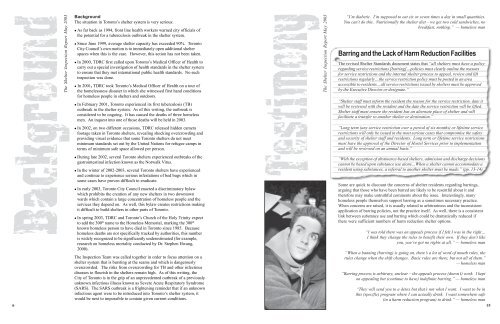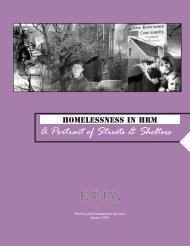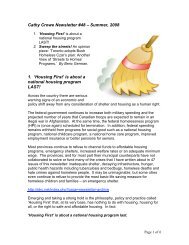Shelter Inspection Report - Toronto Disaster Relief Committee
Shelter Inspection Report - Toronto Disaster Relief Committee
Shelter Inspection Report - Toronto Disaster Relief Committee
Create successful ePaper yourself
Turn your PDF publications into a flip-book with our unique Google optimized e-Paper software.
6<br />
Background<br />
The <strong>Shelter</strong> <strong>Inspection</strong> <strong>Report</strong> May 2003<br />
Background<br />
The situation in <strong>Toronto</strong>’s shelter system is very serious:<br />
• As far back as 1994, front line health workers warned city officials of<br />
the potential for a tuberculosis outbreak in the shelter system.<br />
• Since June 1999, average shelter capacity has exceeded 90%. <strong>Toronto</strong><br />
City Council’s own motion is to immediately open additional shelter<br />
spaces when this is the case. However, this action has not been taken.<br />
• In 2000, TDRC first called upon <strong>Toronto</strong>’s Medical Officer of Health to<br />
carry out a special investigation of health standards in the shelter system<br />
to ensure that they met international public health standards. No such<br />
inspection was done.<br />
• In 2001, TDRC took <strong>Toronto</strong>’s Medical Officer of Health on a tour of<br />
the homelessness disaster in which she witnessed first hand conditions<br />
for homeless people in shelters and outdoors.<br />
• In February 2001, <strong>Toronto</strong> experienced its first tuberculosis (TB)<br />
outbreak in the shelter system. As of this writing, the outbreak is<br />
considered to be ongoing. It has caused the deaths of three homeless<br />
men. An inquest into one of those deaths will be held in 2003.<br />
• In 2002, on two different occasions, TDRC released hidden camera<br />
footage taken in <strong>Toronto</strong> shelters, revealing shocking overcrowding and<br />
providing visual evidence that some <strong>Toronto</strong> shelters do not meet<br />
minimum standards set out by the United Nations for refugee camps in<br />
terms of minimum safe space allowed per person.<br />
• During late 2002, several <strong>Toronto</strong> shelters experienced outbreaks of the<br />
gastrointestinal infection known as the Norwalk Virus.<br />
• In the winter of 2002-2003, several <strong>Toronto</strong> shelters have experienced<br />
and continue to experience serious infestations of bed bugs which in<br />
some cases have proven difficult to eradicate.<br />
• In early 2003, <strong>Toronto</strong> City Council enacted a discriminatory bylaw<br />
which prohibits the creation of any new shelters in two downtown<br />
wards which contain a large concentration of homeless people and the<br />
services they depend on. As well, this bylaw creates restrictions making<br />
it difficult to build shelters in other parts of <strong>Toronto</strong>.<br />
• In spring 2003, TDRC and <strong>Toronto</strong>’s Church of the Holy Trinity expect<br />
to add the 300 th name to the Homeless Memorial, marking the 300 th<br />
known homeless person to have died in <strong>Toronto</strong> since 1985. Because<br />
homeless deaths are not specifically tracked by authorities, this number<br />
is widely recognized to be significantly underestimated (for example,<br />
research on homeless mortality conducted by Dr. Stephen Hwang,<br />
2000).<br />
The <strong>Inspection</strong> Team was called together in order to focus attention on a<br />
shelter system that is bursting at the seams and which is dangerously<br />
overcrowded. The risks from overcrowding for TB and other infectious<br />
diseases to flourish in the shelters remain high. As of this writing, the<br />
City of <strong>Toronto</strong> is in the grip of an unprecedented outbreak of a previously<br />
unknown infectious illness known as Severe Acute Respiratory Syndrome<br />
(SARS). The SARS outbreak is a frightening reminder that if an unknown<br />
infectious agent were to be introduced into <strong>Toronto</strong>’s shelter system, it<br />
would be next to impossible to contain given current conditions.<br />
Testimony<br />
The <strong>Shelter</strong> <strong>Inspection</strong> <strong>Report</strong> May 2003<br />
“I’m diabetic. I’m supposed to eat six or seven times a day in small quantities.<br />
You can’t do this. Nutritionally the shelter diet – we get two cold sandwiches, no<br />
breakfast, nothing.” — homeless man<br />
Barring and the Lack of Harm Reduction Facilities<br />
The revised <strong>Shelter</strong> Standards document states that “all shelters must have a policy<br />
regarding service restrictions [barring]…policies must clearly outline the reasons<br />
for service restrictions and the internal shelter process to appeal, review and lift<br />
restrictions regularly…the service restriction policy must be posted in an area<br />
accessible to residents…all service restrictions issued by shelters must be approved<br />
by the Executive Director or designate.”<br />
“<strong>Shelter</strong> staff must inform the resident the reason for the service restriction, date it<br />
will be reviewed with the resident and the date the service restriction will be lifted.<br />
<strong>Shelter</strong> staff must ensure the resident has an alternate place of shelter and will<br />
facilitate a transfer to another shelter or destination.”<br />
“Long term (any service restriction over a period of six months) or lifetime service<br />
restrictions will only be issued in the most serious cases that compromise the safety<br />
and security of shelter staff and residents. Long term or lifetime service restrictions<br />
must have the approval of the Director of Hostel Services prior to implementation<br />
and will be reviewed on an annual basis.”<br />
“With the exception of abstinence-based shelters, admission and discharge decisions<br />
cannot be based upon substance use alone…When a shelter cannot accommodate a<br />
resident using substances, a referral to another shelter must be made.” (pp. 13-14)<br />
Some are quick to discount the concerns of shelter residents regarding barrings,<br />
arguing that those who have been barred are likely to be resentful about it and<br />
therefore may make untruthful comments about the issue. Interestingly, many<br />
homeless people themselves support barring as a sometimes necessary practice.<br />
When concerns are raised, it is usually related to arbitrariness and the inconsistent<br />
application of barring policies, not the practice itself. As well, there is a consistent<br />
link between substance use and barring which could be dramatically reduced if<br />
there were sufficient numbers of harm reduction shelter options.<br />
“I was told there was an appeals process if I felt I was in the right…<br />
I think they change the rules to benefit their own. If they don’t like<br />
you, you’ve got no rights at all.” — homeless man<br />
“When a banning (barring) is going on, there’s a lot of word of mouth rules, the<br />
rules change when the shift changes. Basic rules are there, but not all of them.”<br />
— homeless man<br />
“Barring process is arbitrary, unclear – the appeals process (doesn’t) work. I kept<br />
on appealing but (continue to have) indefinite barring.” — homeless man<br />
“They will send you to a detox but that’s not what I want. I want to be in<br />
this (specific) program where I can actually drink. I want somewhere safe<br />
(in a harm reduction program) to drink.” — homeless man<br />
15







